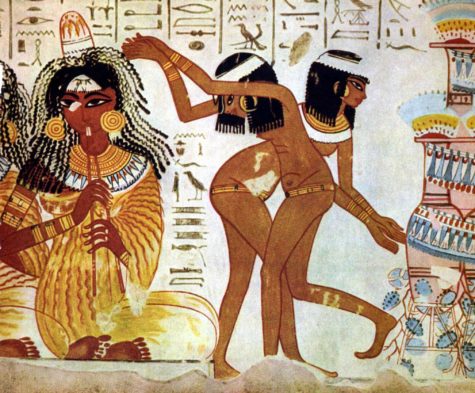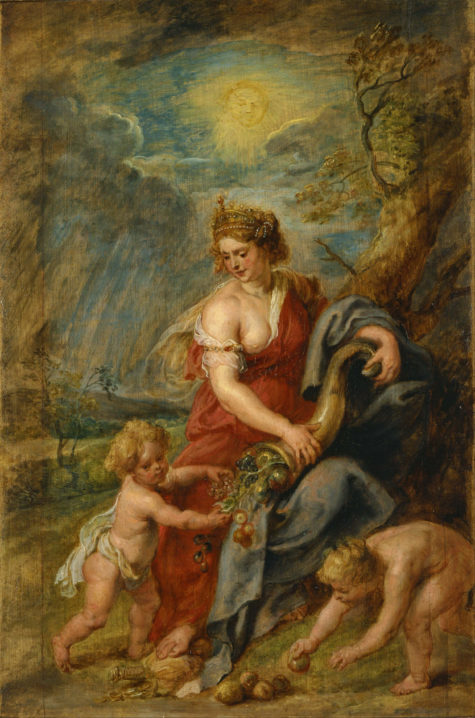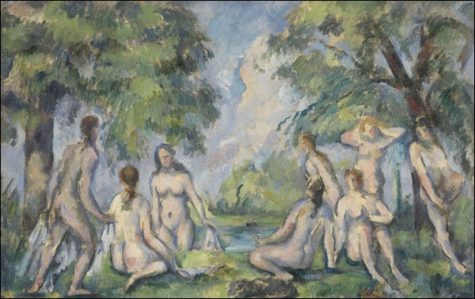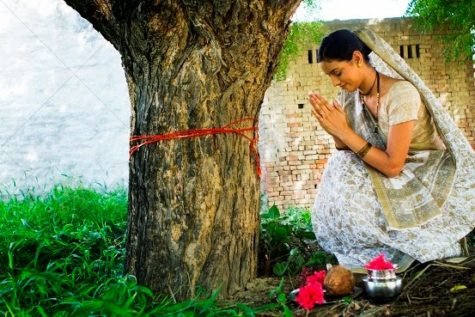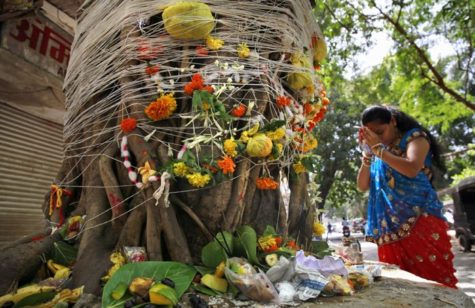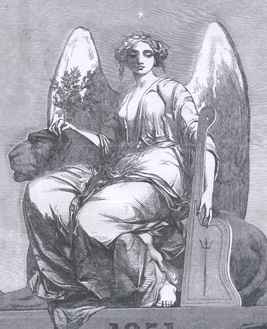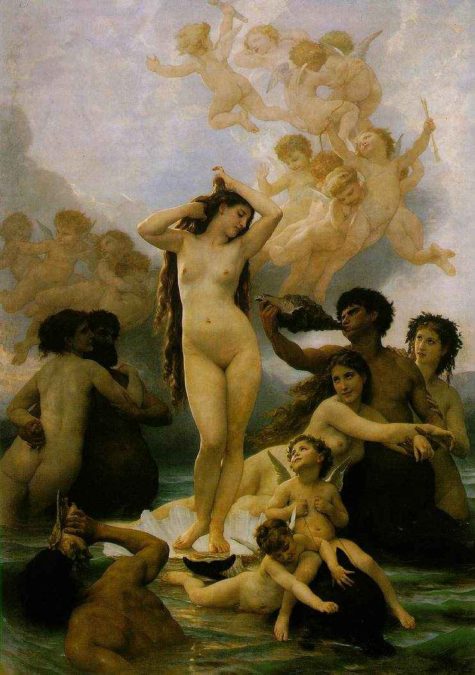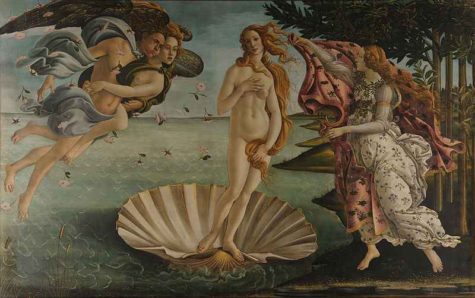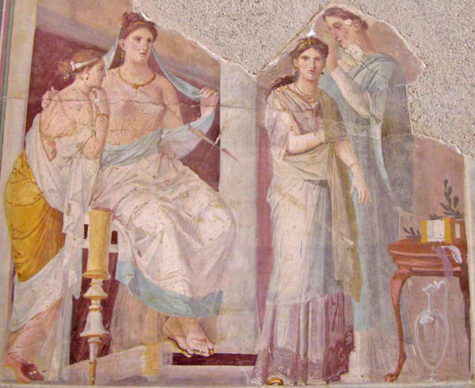Women
According to many pagan calendars, April 15 was the annual festival of Bast. This was Egypt’s most popular festival. A precursor of modern Mardi Gras, it was renowned for parties, revelry, and drunkenness. Herodotus, the Greek traveler and historian writing in the fifth century BCE, claimed that more wine was consumed in Egypt during this festival than during the entire rest of the year. Although many details are lost, Bastet’s festival celebrated female sexuality and generative power.
Boats sailed up the Nile toward Bubastis (her cult city). As each barge approached towns and settlements, it would halt and the mainly female celebrants on board would loudly hail local women congregating on the riverbanks. They would shout sexual obscenities to each other, dance wildly, and perform anasuromai, the ritual act of lifting up the skirts to expose the vulva, associated with laughter, healing, and defiance of grief.
For a socially acceptable way to celebrate:
- Colors: Pink, yellow, clay-color
- Element: Fire
- Daily Meal: Fish.
- Offerings: Give aid to an animal shelter. Give food to household cats.
Altar: Upon a cloth the color of clay, set ten lit candles of pink and yellow, and the figures of many cats. In the center should sit a figure of Bast, and a sistrum. The one who has been chosen to do the work of the ritual should pick up the sistrum before the invocation, with an obeisance to Bast, and it should be shaken after every sentence.
Invocation to Bast
O great Mistress of Cats,
Lady of pleasure in ancient times,
Your eyes sparkle with mischief
And you grant your favors capriciously,
Giving them only where the whim takes you.
Yet we who inhabit this strange world,
Below you yet in power over all your subjects,
We would ask your blessing on us
As we give our blessing to those who are in our mercy.
May we never forget, Lady of tame predators,
Who are not so tame as we might like to believe,
That when we are in a position of power
We should never forget the spirit of those beneath us.
Bless us with joy in life, Lady Bast,
And may we go to our graves
Never forgetting what it is like to play.
Hail Bast! (Repeat response)
Hail Bast! (Repeat response)
Hail Bast! (Repeat response)
For the rest of the afternoon, work should be done at an animal shelter, or spent playing with cats, which on this day alone is not shirking the work. Some folk of the House may choose to be cats themselves for this day; they need do no work, and it is lucky to pet them, but they must not stand on two legs or the spell will be broken. During this time, they must meditate on what it is to be in the strange predicament of the tamed predator who is dependent on the whims of humans
From:
- Encyclopedia of Spirits
- Pagan Book of Hours
The Goddess Carmenta is celebrated on two dates of the Roman calendar, (January 11 and 15), each day called Carmentalia. These dates should be considered as two separate festivals, rather than one festival extending over this period, yet it is not clear to us today, any more than it was during the Late Republic, why two such holidays should be in such close proximity in one month.
The festival, chiefly observed by women, celebrates Carmenta, who is the Goddess of women’s health, birthing, and prophecy. She is the inventor of letters, as Minerva is the inventor of numbers. She tells the future through Her sister Porrima and reveals the past through Her sister Postvorta, while Carmenta knows all that happens in the present.
Together the three Carmenae sisters are the Good Fates, the Three Mothers, and the Muses. The very name of Carmenta was given to song (carmen) and Latin terms for poetry, charms, and speaking-in-tongues. With Her songs she would soothe the ill and taught women how to care for themselves and their children. Her sanctuaries thus became places for women and children to receive traditional medical treatments using herbs and music.
Carmenta takes us back to a very early period, a time well before the beginnings of Rome around three thousand years ago, back into the Italian Bronze Age. She takes us back to the ecstatic tradition of the female priestesses called vates in which Latin religion began and in which the Religio Romana was first founded.
The sacred grove of Carmenta, the most ancient sanctuary in all of Rome, was located at the foot of the Capitoline Hill. It is still visited today where people gather waters from Her sacred spring. It was in this very grove that Carmenta appeared to Numa Pompilius in his dreams as the nymph Egeria. She instructed Numa on how to commune with the Gods.
With Egeria’s instruction, Numa Pompilius then established rituals for the Gods, festivals, and a calendar by which the Romans could attend these. Numa set out sanctuaries for Gods and Goddesses and he created colleges of priests and priestesses to serve the Gods and Goddesses. Egeria taught Numa the laws which he handed down to the Romans and which still govern our sacramental rituals today.
One of the laws of Numa states:
“The Gods are not to be represented in the form of man or beast, nor are there to be any painted or graven image of a deity admitted (to your rites).”
As one of the oldest Goddesses of Rome, whose worship was established by Numa, Carmenta was never represented by an image. It was sufficient to feel Her presence in the sacred grove below the Capitoline. In the same way, Vesta, Goddess of the Hearth, is never represented by an image but only by living fire.
Another law of Numa holds that:
“Sacrifices are not to be celebrated with an effusion of blood, but consist of flour, wine, and the least costly of offerings.”
The restriction against the use of blood sacrifices was so strong in the worship of Carmenta that no one was allowed to enter Her sacred grove wearing anything made of leather or animal hide. It is not right to take the life of another creature in worshiping the Goddess who helps birth life into the world. And thus it follows that today we offer Carmenta bay leaves as incense, a libation of milk, and popana cakes made of soft cheese and flower.
Invocation to Carmenta
Goddess of Women’s Health
Come, be present, Carmenta.
May Your sisters Porrima and Postvorta attend You.
With joyful mind come, Mother Carmenta, on You I call,
Come, stand by me, stay, and listen to my pleas.
Speak to me once more, in Your own words, as You did before.
In Your sacred grove where Egeria counseled King Numa,
bear forth now Your soothing songs to dispel our sorrows.
Come forth! I call to You, Good Goddess,
Great Goddess of charms.
Give voice, happy Voice of song,
With soothing songs as will cure our ills, or whatever else we fear.
Spare our daughters heavy with child, spare our wives in their pangs of labor,
Care for the mothers who worry over their children.
With pious rite I call out, I summon,
I entice with songs that You come forth, Carmenta,
And look favorably upon the matrons of our families.
In You, dearest Mother, in Your hands we place our safekeeping.
In offering to You this cake of cheese I pray good prayers
in order that, pleased with this offering of popana,
May You be favorable towards our children and to us,
Towards our homes and our households.
More About The Festivals:
According to legend, the cult of Carmenta predated Rome itself. In some accounts She was known as Nicostrate, the mother of Evander, who was fathered by Mercurius. Evander was the legendary founder of Paletum, a village that gave its name to the Palatine Hill. Her sacred grove, therefore, may have originally lain beneath the Palatine Hill as some ascribe it.
Indeed, it may be that it was in Her sacred grove beneath the Palatine that Romulus and Remus were said to have been discovered being suckled by a she-wolf, since Carmentis was so closely associated with the care of infants.
It was said that later Numa Pompilius founded a sacred grove for Her beneath the Capitoline Hill. The dedication of two groves to Carmentis is one possible reason why there were two days celebrated as Carmentalia in the month of January.
It was proposed by Huschke that the two festival days represented the Latins of Romulus and the Sabines of Titus Tatius, just as there were two companies of Luperci and two companies of Salii. Were that the case we might expect that She once had a sacred grove on the Esquiline Hill, and that Numa’s dedication beneath the Capitoline represented a union of the two culti Carmentalis.
The fasti Praeneste suggests that the second date was added by a victorious Roman general who had left the City by the Porta Carmentalis for his campaign against Fidenae. The gate received its name from its proximity to the sacred grove of Carmentis.
Yet another story was told by Ovid, linking the two dates to a protest by the matrons of Rome in 195 BCE. During the fourth century the Roman Senate had granted patrician matrons the privilege of riding in two- wheeled carriages in reward for their contribution in gold to fulfilling a vow to Apollo made by Camillus. The privilege was later to be temporarily revoked during the Second Punic War (215 BCE) along with sumptuary laws that limited the use of colored cloth and gold that women could wear, in order to save on private expenses and war materials (horses) and thus help in the war effort.
But the Senate did not at first renew the privileges at war’s end. In 195 Tribunes Marcus Fundanius and Lucius Valerius finally called for the repeal of this lex Oppia, but they were opposed by the brothers Marcus and Publius Junius Brutus.
Supporters for repealing the lex Oppia, and those who supported its remaining in effect, gathered daily on the Capitoline to argue over the matter. Soon women began to join in the disputes, their numbers increasing daily, even so much as women from the countryside entered into the City to advocate for their rights. The natural place for them to first congregate would have been at the grove of Carmentis. This may be what Ovid indicates by linking the protest to the Carmentalia.
Consul Marcius Porcius Cato spoke out against repealing the lex Oppia. The women then resolved to “refuse to renew their ungrateful husbands’ stock” until their privileges were restored, Ovid referring to the women resorting to abortion as their means of protest.
In a later period the Temple of the Bona Dea would become associated with the use of abortive herbs, and Carmentis associated with the use of the same herbs in birthing. In actuality both Carmentis and the Bona Dea were associated with birthing or prevention of pregnancy, and the difference between the Capitoline and Aventine temples may have been one of class distinction. Eventually the matrons of Rome regained their rights and, according to Ovid, the second Carmentalia was then begun in thanks to the Goddess for Her support. Ovid’s story is the least likely and most fanciful to account for the two Carmentaliae of January.
The notion that there may have earlier been two groves dedicated to Carmentis prior to the known grove beneath the Capitoline is a reasonable speculation, but still would not account for the two festivals. We are left then with the information provided by the Fasti Praeneste, although the inscription is mutilated and uncertain. This source may indicate that while the Carmentalia held on 11 January was dedicated to Carmentis, that of 15 January was intended to honor Janus as guardian of the Porta Carmentalis.
Different aspects of Carmentis related to Janus, and thus it is possible that a festival for Him would include Carmentis in similar fashion as festivals for Ops and Consus. The fact remains that we don’t know today why the month of January has two separate festivals for Carmentis.
Ritual for the Festival of Carmenta
- Color: Red
- Element: Earth
- Offerings: Give gifts to pregnant women in need.
- Daily Meal: Eggs.
- Altar: Upon a red cloth place seven red candles and the figure of a pregnant woman. If possible, a woman who is with child should be present and honored on this day.
Carmentalia Invocation
All things grow in the dark place
Safe within the womb of the Mother,
Safe within the dream of the Mother.
The Earth lies now asleep
Full with big belly,
Each seed pregnant with hopes
Waiting for the return of the Sun.
So we are each of us,
Pregnant with hopes and dreams,
Big-bellied in our minds,
Waiting to for the moment
To begin our sacred labor.
This is the time of waiting,
Feeling the child within come to fruition,
Feeling it grow and change,
Feeling the faint motions
That signify the oncoming flood of life.
Call: May Life burst forth in a flood of joy!
Response: May Life come forth through the gate of eternity!
Call: We hail the Mother beneath our feet!
Response: We hail the Mother within our souls!
Call: We hail the Mothers from whence we descended!
Response: We hail the Mothers that are yet to bring forth!
Call: We hail the growth of possibility!
Response: We hail all that it yet to come!
Call: We hail the growth of the future!
Response: We wait for the birthing-time with open arms!
Chant:
Mother I feel you under my feet
Mother I hear your heart beat
Sources:
Formerly known as Woman Suffrage Day, August 26 marks the ratification of the 19th Amendment to the U.S. Constitution (1920), granting women the right to vote. Ratification came in Tennessee, where suffragist (Anitia) Lili Pollitzer, age 25, persuaded Tennessee state legislator Harry T. Burn, age 24, to cast the deciding vote.
“I know that a mother’s advice is always safest for a boy to follow,” he said, “and my mother wanted me to vote for ratification.”
The country’s 26 million voting-age women were enfranchised by this change in the Constitution. Longtime suffragist Carrie Chapman Catt summed up her experiences in the battle this way: “Never in the history of politics has there been such a nefarious lobby as labored to block the ratification.”
Upon ratification, Catt founded the League of Women Voters, an organization now dedicated to providing impartial, in-depth information about candidates, platforms, and ballot issues.
From: Almanac.com
July 10th is Lady Godiva Day. I’m sure we’re all familiar with the story – but here it is again:
The Countess Godiva devoutly anxious to free the city of Coventry from a grievous and base thralldom often besought the Count, her husband, that he would for love of the Holy Trinity and the sacred Mother of God liberate it from such servitude. But he rebuked her for vainly demanding a thing so injurious to himself and forbade her to move further therin.
Yet she, out of her womanly pertinacity, continued to press the matter insomuch that she obtained this answer from him: “Ascend,” he said, “thy horse naked and pass thus through the city from one end to the other in sight of the people and on thy return thou shalt obtain thy request.”
Upon which she returned: “And should I be willing to do this, wilt thou give me leave?”
“I will,” he responded.
Then the Countess Godiva, beloved of God, ascended her horse, naked, loosing her long hair which clothed her entire body except her snow white legs, and having performed the journey, seen by none, returned with joy to her husband who, regarding it as a miracle, thereupon granted Coventry a Charter, confirming it with his seal.
From the Flores Historiarum by Roger of Wendover
In ancient Rome on July 7th, the Feria Ancillarum or Festival of Handmaids was held. This was the maids’ day out, when the maids of Rome were beyond the control of their mistresses.
Also known as the Caprotinae, when free and slave women made offerings to her beneath wild fig trees outside Rome’s city limits, this feast day was in honor of Juno Caprotina, Juno of the Wild Figs. Fig trees were venerated, with feasting beneath them in honor of Caprotina, an aspect of the Goddess Juno.
In this aspect of the goddess, Juno is seen as dressed in goatskins and driving a chariot pulled by goats. Enslaved women made up a large proportion of her devotees.
The dates for this ritual varies from year to year. The word ‘Purnima’ means full moon, therefore the Vat purnima vrat is observed on the full moon day (15th day) of the Hindu month of Jyeshtha that is during the month of May-June as per the Gregorian calendar. In 2017, this falls on June 9. In 2018 it will fall on June 27.
Vat Purnima or Wat Purnima (वट पूर्णिमा, vaṭapūrṇimā, also called Vat Savitri is a celebration observed by married women in the Western Indian states of Gujarat, Maharashtra, Karnataka and some regions of eastern Uttar Pradesh. On this Purnima, a married woman marks her love for her husband by tying a ceremonial thread around a banyan tree. The celebration is based on the legend of Savitri and Satyavan as narrated in the epic Mahabharata.
The Legend:
The legends dates back to a story in the age of Mahabharata. The childless king Asvapati and his consort Malavi wish to have a son. To have a child, he performed penances and offered prayers. Finally the God Savitr appears and tells him he will soon have a daughter. The king is overjoyed at the prospect of a child. She is born and named Savitri in honor of the god.
Since she was born due to her father’s severe penances, she naturally led an ascetic life. However, she is so beautiful and pure,all the men in her village are intimidated and no man will ask for her hand in marriage. Her father tells her to find a husband on her own. She sets out on a pilgrimage for this purpose and finds Satyavan, the son of a blind king named Dyumatsena who lives in exile as a forest-dweller. Savitri returns to find her father speaking with Sage Narada who tells her she has made a bad choice: although perfect in every way, Satyavan is destined to die one year from that day.
Her father asked her to find someone else, but she refused, saying that she could select a man only once in a lifetime since she was of an ascetic spirit. Narada and her father agree. Savitri insists on going ahead and marries Satyavan.
 Three days before the foreseen death of Satyavan, Savitri takes a vow of fasting and vigil. Her father-in-law tells her she has taken on too harsh a regimen, but she replies that she has taken an oath to perform the regimen and Dyumatsena offers his support. The morning of Satyavan’s predicted death, he is splitting wood and suddenly becomes weak and lays his head in Savitri’s lap and dies.
Three days before the foreseen death of Satyavan, Savitri takes a vow of fasting and vigil. Her father-in-law tells her she has taken on too harsh a regimen, but she replies that she has taken an oath to perform the regimen and Dyumatsena offers his support. The morning of Satyavan’s predicted death, he is splitting wood and suddenly becomes weak and lays his head in Savitri’s lap and dies.
Savitri places his body under the shade of a Vat (Banyan) tree. Soon, the messengers of Yama appear on the scene to take away her husband, but Savitir refuses to hand her husband over to them. They can not take him away until Lord Yama Himself appears. Savitri follows him as he carries the soul away. She offers him praise. Lord Yama, impressed by both the content and style of her words, and seeing her matchless devotion, spiritual knowledge, and determination, offers her a boon.
She first asks for eyesight and restoration of the kingdom for her father-in-law, then a hundred children for her father, and then a hundred children for herself and Satyavan. The last wish creates a dilemma for Yama, as it would indirectly grant the life of Satyavan. However, impressed by Savitri’s dedication and purity, he asks her to wish one more time, “forgetting” to mention his denial to grant the third wish.
Savitri immediately asked for the life of Satyavan. The death god Yama who does not spare even an ant, grants life to Satyavan and blesses Savitri’s life with eternal happiness.
Satyavan awakens as though he has been in a deep sleep and returns to his parents along with his wife. Meanwhile, at their home, Dyumatsena regains his eyesight before Savitri and Satyavan return. Since Satyavan still does not know what happened, Savitri relays the story to her parents-in-law, husband, and the gathered ascetics. As they praise her, Dyumatsena’s ministers arrive with news of the death of his usurper. Joyfully, the king and his entourage return to his kingdom.
Though the tree does not play a significant role of the story, The banyan tree holds a unique significance in Hindu religion. As per the Hindu scriptures, it holds the essence of the three great Gods in Hindu mythology, Brahma-Vishnu-Mahesh. The roots represents Brahma, the stem of Vat Vriksha is Vishnu while Shiva represents the upper part. It is believed that performing the rituals of the puja under this sacred tree, the devotees can fulfill all their desires. It is also worshiped in memory of the love in the legend.
Observing the Vat Purnima:
The festival is followed by married women only, and is prohibited for children and widows. On this day wives pray to the Divine for their husbands’ prosperity and longevity by performing Vat Purnima Puja Vidh which includes tying ritual threads around the trunk of a banyan tree; this ritual is also called the Peepal Puja.
In the present day, the festival is celebrated in the following way. Women dress in fine saris and jewelry, and their day begins with the offering of any five fruits and a coconut. Each woman winds white thread around a banyan tree seven times as a reminder of their husbands. They fast for the whole day.
The fast is also sometimes observed throughout the night until the next morning. The next morning women break their fast and offer charity to Brahmins. Women engage in the worship of a banyan tree, and listen to the legend of Savitri.
After, the women offer water to the tree and spread red powder (kumkum) on it, cotton threads are wrapped around the tree’s trunks and they do parikrama or circumambulate seven times around it.
Alternatively, on the occasion of Vat Purnima, women keep a fast of three days for their husbands, as Savitri did. During the three days, pictures of a Vat (banyan) tree, Savitri, Satyavan, and Yama, are drawn with a paste of sandal and rice on the floor or a wall in the home. The golden engravings of the couple are placed in a tray of sand, and worshiped with mantras (chanting), vermilion, saffron, sandalwood incense, fruit, and Vat leaves.
Outdoors, the banyan tree is worshiped. A thread is wound around the trunk of the tree, and copper coins are offered. Strict adherence to the fast and tradition is believed to ensure the husband a long and prosperous life. During the fast, women greet each other with “जन्म सावित्री हो” (English: “Become a Savitri”). It is believed that until the next seven births their husband will live well.
Just in the way that Savitri got her husband, Satyavan back from Yumraj, it is known that women who observe this auspicious fast will be blessed with good fortune and blissful married life.
Information collected from various sources.
The Bona Dea had a festival on the first of May that commemorated the date her Aventine temple was founded. Its date connects her to Maia; its location connects her to Rome’s plebeian commoner class. At the ceremony, prayers were made to Her to avert earthquakes. She also had a secret festival, attended only by women, that took place over the night of the 3rd and 4th of May.
The rites are inferred as some form of mystery, concealed from the public gaze and, according to most later Roman literary sources, entirely forbidden to men.
On this night the festival was held in the house of the consul (the chief elected official), and no men were allowed. This taboo extended even to paintings or statues of men, which were required to be covered during the rites—and one assumes the consul himself crashed at a friend’s place for the night. The Vestal Virgins officiated, led by the wife of the consul (probably symbolic of the ancient Queen, on whom fell certain sacred religious duties), and the house was decorated like a temple with garlands of leaves and flowers of all kinds, except for myrtle of course, and the women wore wreaths of grape leaves.
A great jar of wine was placed in the room, though it must be referred to as “milk”, and the jar itself was called a mellarium, or “honey jar.” After making libations to the Goddess, music was played and the women drank and danced.
In the Republican era, Bona Dea’s Aventine festivals were probably distinctly plebeian affairs, open to all classes of women and perhaps, in some limited fashion, to men. By the Late Republic era, Bona Dea’s May festival and Aventine temple could have fallen into official disuse, or official disrepute.
The goddess also had a Winter festival (see it here), it was held in December during the Faunalia, and was referred to as the sacra opertum, (“the secret or hidden sacrifice”): at this ritual sacrifices were made for the benefit of all the people of Rome, something proper to the realm of a mother or Earth Goddess who is concerned with the well-being of all of Her children.
Ritual for Bona Dea:
- Color: Green
- Element: Earth
- Offerings: Leave a pig-shaped cookie out for the wild things.
- Daily Meal: Soups or stews, preferably with herbs. Herbal tea.
Altar:
Upon a green cloth set five candles in different colors, a chalice of milk mixed with honey, incense of sandalwood and myrrh, the figure of a snake, a plate of cookies shaped like pigs, a pot of medicinal herbal tea, cups, and pots of dried herbs gathered throughout the year.
Invocation to Bona Dea
O Bona Dea,
Good Goddess of the Earth
Whose name is mystery,
Whose name is a hundred names,
Whose spirit lives in us all
And in every goddess who touches the soil,
And in every mortal who sprang from the clay,
Be with us on this day!
You have made the Earth spring forth
With many green goods for us,
Not merely those with which me feed our bellies,
But also those which heal our bodies.
Lady who heals us, godmother of Hygeia,
Daughter of Faunus who tracks in the wild,
We find your gifts both in our gardens
And on the wild paths where you have trodden.
We see the healing herbs springing up
In each of your passing footprints,
And we are grateful for our lives.
O Bona Dea,
Good Goddess of the Earth
Whose name is mystery
But whose gifts are so concrete,
We revere you and ask that you bless this day
Your plants which you have so generously given us,
That we may always be healed
And always help to heal others.
The names of the herbs that were collected and placed on the altar are called out one by one, in this manner:
“For the power of Rosemary, we are grateful!”
All reply in turn, “We are grateful!”
Pass the tea and cookies and eat them.
Sources: Pagan Book of Hours and Wikipedia
The Veneralia (April 1) was the Ancient Roman festival of Venus Verticordia (“Changer of hearts”), the goddess of love and beauty. The worship of the goddess Fortuna Virilis (“Bold fortune”) was also part of this festival.
In Rome, jewelry was ritually removed from the statue of the goddess, her image was then taken from her temple to the men’s baths, where it was undressed and washed in warm water by her female attendants, then garlanded with myrtle.
Similarly, women bathed themselves in the public baths wearing wreaths of flowers and myrtle on their heads. It was generally a day for women to seek divine help in their relations with men. Men also asked Venus Verticordia for her help in affairs of the heart, sex, betrothal and marriage.
Here’s a nice ritual for the Day of Venus:
- Color: Sea green, golden, and pink
- Element: Water
- Altar: Upon cloth of sea green, golden and pink, set many shells, flowers, beautiful ornaments, pink candles, hearts, doves, incense of rose and violets, and a great chalice of white wine.
- Offerings: Hearts and flowers. Giving a gift of love to someone.
- Daily Meal: Seafood. Angel hair pasta. Sweet breads, cakes, and desserts.
Invocation to Venus
Hail, Lady of the Morning Star!
You who rose form the sea foam,
Born of the impersonal severed phallus of the sky
Immersed in the impersonal womb of the sea,
You who rode to shore on a shell of pearl
And whose powers no one can resist
Save the virgin goddesses,
You who bring the glow of gold
Into the lives of all whom you touch,
Lady, we revere you as the avatar
Of the love between equals
Who look each other in the eye,
The attraction and pursuit
Between every particle in the universe.
Hail, Lady of the Evening Star!
You who rule the night
With its darker passions,
You who tempt the wistful heart,
You whose hands reach out
To all the world and more,
Lady, we revere you as a force of nature
Far greater than merely the human heart,
For you are the force that binds together
All that dances with another of its kind
In the endless dance of creation.
(The wine is passed around, and poured as a libation to Venus. Each takes a flower and wears it in honor of Venus.)
Chant:
Venus Veritas
Amor Amor
Source: Wikipedia and Pagan Book of Hours
The goddess Bona Dea also had a May festival, which is better known. The winter festival was held in December, at the home of the current senior annual Roman magistrate cum imperio, whether consul or praetor. It was hosted by the magistrate’s wife and attended by respectable matrons of the Roman elite. This winter festival is not marked on any known religious calendar but was dedicated to the public interest and supervised by the Vestals, and therefore must be considered official.
Men were not allowed to know Her name, never mind speak it, and they were also forbidden from Her secret festival. There were other taboos concerning the worship of the Bona Dea: neither wine nor myrtle were to be mentioned by name during Her secret festival, likely because they were both sacred to Her and therefore very powerful.
Shortly after 62 BC, Cicero presents it as one of very few lawful nocturnal festivals allowed to women, privileged to those of aristocratic class, and coeval with Rome’s earliest history.
Festival Rites:
The Winter festival is known primarily through Cicero’s account, supplemented by later Roman authors. First, the house was ritually cleansed of all male persons and presences, even male animals and male portraiture. Then the magistrate’s wife and her assistants made bowers of vine-leaves, and decorated the house’s banqueting hall with “all manner of growing and blooming plants” except for myrtle, whose presence and naming were expressly forbidden.
A banquet table was prepared, with a couch (pulvinar) for the goddess and the image of a snake. The Vestals brought Bona Dea’s cult image from her temple and laid it upon her couch, as an honored guest. The goddess’ meal was prepared: the entrails of a sow, sacrificed to her on behalf of the Roman people, and a libation of sacrificial wine.
The festival continued through the night, a women-only banquet with female musicians, fun and games, and wine; the last was euphemistically referred to as “milk”, and its container as a “honey jar”. The rites sanctified the temporary removal of customary constraints imposed on Roman women of all classes by Roman tradition, and underlined the pure and lawful sexual potency of virgins and matrons in a context that excluded any reference to male persons or creatures, male lust or seduction.
According to Cicero, any man who caught even a glimpse of the rites could be punished by blinding. Later Roman writers assume that apart from their different dates and locations, Bona Dea’s December and May 1 festivals were essentially the same.
Sources: Wikipedia and Thalia Took
 July 9th is the Day of Unn the Wise person. Also known as Aud the Deep-Minded, Unn was a great matriarch who established dynasties in the islands Orcadas, Feroe and Iceland.
July 9th is the Day of Unn the Wise person. Also known as Aud the Deep-Minded, Unn was a great matriarch who established dynasties in the islands Orcadas, Feroe and Iceland.
Example to follow:
Make our own families grow strong, maintain the memory and traditions of our alive ancestors. Remember the great women of your own clan on this Day of Remembrance for Unn the Deep Minded.
About Unn:
Unn was a powerful figure from the Laxdaela Saga who emigrated to Scotland to avoid the hostility of King Harald Finehair. She was the second daughter of Ketill Flatnose, a Norwegian hersir, and Yngvid Ketilsdóttir, daughter of Ketill Wether, a hersir from Ringarike. Unn married Olaf the White (Oleif), son of King Ingjald, who had named himself King of Dublin after going on voyages to Britain and then conquering the shire of Dublin. They had a son named Thorstein the Red
She established dynasties in the Orkney and Faroe Islands by carefully marrying off her grand daughters. Unn then set off for Iceland.
On her ship were twenty men, all of whom were free, but she was still the leader of them, proving that she was respected, but also that she was strong-willed enough to command a ship alone without the help of a man. In addition to the crew, there many other men on her ship, prisoners from Viking raids near and around Britain. They all came from good families, and were called bondsmen. Unn gave these men their freedom once they were in Iceland, making them freed-men, a class between slave and free, where they were not owned, but did not have all the rights of a free man. She also gave them all a great deal of land to farm on and make a living.
As a settler in Iceland she continued to exhibit all those traits which were her hallmark-strong will, a determination to control, dignity, and a noble character. In the last days of her life, she established a mighty line choosing one of her grandsons as her heir. She died during his wedding celebration, presumably accomplishing her goals and working out her destiny in this life. She received a typical Nordic ship burial, surrounded by her treasure and her reputation for great deeds.
Note:
In some pagan calendars this is shown of “Day of Un the Wise Person” which is a misprint.
Source: Asatru.org
